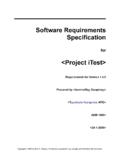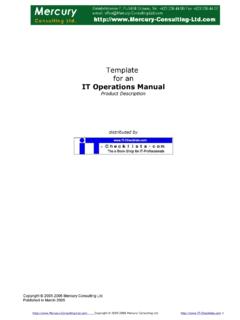Transcription of Memento Chain of Responsibility Observer State Strategy ...
1 +visitElementA(in a : ConcreteElementA)+visitElementB(in b : ConcreteElementB) interface Visitor+visitElementA(in a : ConcreteElementA)+visitElementB(in b : ConcreteElementB)ConcreteVisitor+accept( in v : Visitor) interface Element+accept(in v : Visitor)ConcreteElementA+accept(in v : Visitor)ConcreteElementBClientVisitorTyp e:BehavioralWhat it is:Represent an operation to be performed on the elements of an object structure. Lets you define a new operation without changing the classes of the elements on which it operates.+templateMethod()#subMethod()Ab stractClass+subMethod()ConcreteClassTemp late MethodType:BehavioralWhat it is:Define the skeleton of an algorithm in an operation, deferring some steps to subclasses.
2 Lets subclasses redefine certain steps of an algorithm without changing the algorithm's structure.+execute()ConcreteStrategyB+ex ecute() interface StrategyContext+execute()ConcreteStrateg yAStrategyType:BehavioralWhat it is:Define a family of algorithms, encapsulate each one, and make them interchangeable. Lets the algorithm vary independently from clients that use it.+handle()ConcreteState1+handle() interface State +request()Context+handle()ConcreteS tate2 StateType:BehavioralWhat it is:Allow an object to alter its behavior when its internal State changes. The object will appear to change its +update()-observerStateConcreteObserver+ update() interface Observernotifiesobserves+attach(in o : Observer )+detach(in o : Observer )+notify() interface SubjectObserverType:BehavioralWhat it is:Define a one-to-many dependency between objects so that when one object changes State , all its dependents are notified and updated +setMemento(in m : Memento )+createMemento()-stateOriginator CaretakerMementoType:BehavioralWhat it is.
3 Without violating encapsulation, capture and externalize an object's internal State so that the object can be restored to this State FactoryCAdapterSBridgeSBuilderCChain of ResponsibilityBCommandBCompositeSDecorat orSFacadeSFactory MethodCFlyweightSInterpreterBIteratorBMe diatorBMementoBPrototypeCProxySObserverB SingletonCStateBStrategyBTemplate MethodBVisitorBChain of Responsibility +handleRequest() interface Handler+handleRequest()ConcreteHandler1+ handleRequest()ConcreteHandler2 ClientsuccessorType:BehavioralWhat it is:Avoid coupling the sender of a request to its receiver by giving more than one object a chance to handle the request. Chain the receiving objects and pass the request along the Chain until an object handles it.
4 +execute()ConcreteCommandClient+action() ReceiverInvokerCommandType:BehavioralWha t it is:Encapsulate a request as an object, thereby letting you parameterize clients with different requests, queue or log requests, and support undoable operations.+interpret() interface AbstractExpression+interpret() : ContextTerminalExpressionClientContext+i nterpret() : ContextNonterminalExpressionInterpreterT ype:BehavioralWhat it is:Given a language, define a representation for its grammar along with an interpreter that uses the representation to interpret sentences in the language.+createIterator() interface Aggregate+createIterator() : ContextConcreteAggregate+next() interface Iterator+next() : ContextConcreteIteratorIteratorType:Beha vioralWhat it is:Provide a way to access the elements of an aggregate object sequentially without exposing its underlying interface ColleagueinformsupdatesMediatorType:Beha vioralWhat it is:Define an object that encapsulates how a set of objects interact.
5 Promotes loose coupling by keeping objects from referring to each other explicitly and it lets you vary their interactions 2007 Jason S. , Erich; Helm, Richard; Johnson, Ralph; Vlissides, John (1995). Design Patterns: Elements of Reusable Object-Oriented Software. Reading, Massachusetts: Addison Wesley Longman, +execute()CommandFacadeComplex systemAdapterType:StructuralWhat it is:Convert the interface of a class into another interface clients expect. Lets classes work together that couldn't otherwise because of incompatible interfaces.+adaptedOperation()Adaptee+op eration() interface Adapter+operation()-adapteeConcreteAdapt erClient+operationImpl() interface Implementor+operation()Abstraction+opera tionImpl()ConcreteImplementorA+operation Impl()ConcreteImplementorBBridgeType:Str ucturalWhat it is:Decouple an abstraction from its implementation so that the two can vary independently.
6 +operation()Leaf+operation()+add(in c : Composite)+remove(in c : Composite)+getChild(in i : int)Composite+operation()+add(in c : Composite)+remove(in c : Composite)+getChild(in i : int) interface ComponentchildrenCompositeType:Structura lWhat it is:Compose objects into tree structures to represent part-whole hierarchies. Lets clients treat individual objects and compositions of objects uniformly.+operation()ConcreteComponent+ operation()Decorator+operation() interface Component+operation()+addedBehavior()-ad dedStateConcreteDecoratorDecoratorType:S tructuralWhat it is:Attach additional responsibilities to an object dynamically. Provide a flexible alternative to sub-classing for extending :StructuralWhat it is:Provide a unified interface to a set of interfaces in a subsystem.
7 Defines a high-level interface that makes the subsystem easier to :StructuralWhat it is:Use sharing to support large numbers of fine grained objects efficiently.+request()RealSubject+reques t()Proxy+request() interface SubjectClientrepresentsProxyType:Structu ralWhat it is:Provide a surrogate or placeholder for another object to control access to it.+static instance()+SingletonOperation()-static uniqueInstance-singletonDataSingletonSin gletonType:CreationalWhat it is:Ensure a class only has one instance and provide a global point of access to it.+clone()ConcretePrototype2+clone() interface PrototypeClient+clone()ConcretePrototype 1 PrototypeType:CreationalWhat it is:Specify the kinds of objects to create using a prototypical instance, and create new objects by copying this prototype.
8 interface ProductConcreteProduct+factoryMethod()Co ncreteCreator+factoryMethod()+anOperatio n()CreatorFactory MethodType:CreationalWhat it is:Define an interface for creating an object, but let subclasses decide which class to instantiate. Lets a class defer instantiation to subclasses.+buildPart() interface Builder+buildPart()+getResult()ConcreteB uilder+construct()DirectorBuilderType:Cr eationalWhat it is:Separate the construction of a complex object from its representing so that the same construction process can create different representations. interface AbstractProductConcreteProduct+createPro ductA()+createProductB() interface AbstractFactory+createProductA()+createP roductB()ConcreteFactoryClientAbstract FactoryType:CreationalWhat it is:Provides an interface for creating families of related or dependent objects without specifying their concrete class.
9 +operation(in extrinsicState)-intrinsicStateConcreteFl yweight+operation(in extrinsicState)-allStateUnsharedConcrete Flyweight+operation(in extrinsicState) interface Flyweight+getFlyweight(in key)FlyweightFactoryClientCopyright 2007 Jason S. , Erich; Helm, Richard; Johnson, Ralph; Vlissides, John (1995). Design Patterns: Elements of Reusable Object-Oriented Software. Reading, Massachusetts: Addison Wesley Longman.





